How To Install Configuration Manager Console 2012
Organisation Center Configuration Manager 2022 can automate nearly whatsoever installation, including the deployment of its own management panel. This guide covers the Console deployment, avant-garde settings, and dynamic device collections.
- Author
- Contempo Posts
![]()
By default, an SCCM installation includes console access only on site servers. Additional installation can be handled past several methods. The two most common are:
- Manually installing from the SCCM 2022 installation media
- Configuring an application deployment using the extracted installer
We are all responsible automating administrators here, so we will be taking choice 2. Our first step is to prepare the content.
ConsoleSetup.exe and SCCM application deployments ^
Everything was so much more than complicated in SCCM 2007, including the Authoritative Console deployment. In an SCCM 2022 environment, the Configuration Manager Panel installer is easily accessed by browsing to \\SiteServer\SMS_SiteCode\tools\ConsoleSetup\.

The SCCM 2022 Management Console installer
Don't get too excited about the AdminConsole.msi file, though. Microsoft recommends that the deployment be controlled past ConsoleSetup.exe.
Brainstorm by copying the entire contents of the ConsoleSetup folder to a software deployment share. I adopt to apply a DFS namespace for my UNC because that gives me quite a bit of boosted flexibility. For system, content is stored like this:
DFS Name: Test.local\Software
Folder: \Microsoft\System Center\2012R2SP1\ConsoleSetup
Storing the Panel installer in a separate folder structure makes future Console upgrades much easier. Be sure that your domain computers have read execute to the share and to the folder structure itself.
With the content in your software share, launch the Configuration Director Console. If this is your start deployment of the Console, you may demand to launch it directly on your site server. Navigate to Software Library – Application Management – Applications. In the ribbon UI, select Create Application.
Go out the default Automatically discover information choice selected and enter the total path to the AdminConsole.msi. Click Next.
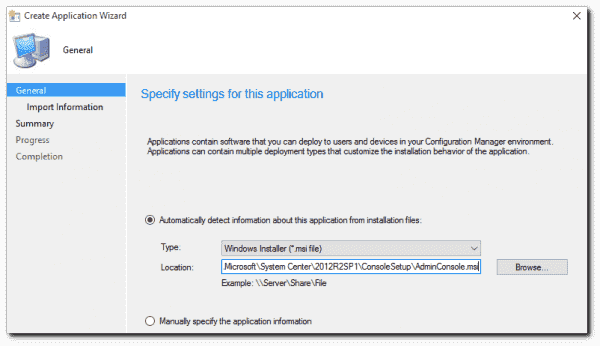
Specifying the AdminConsole.msi for the installation file
Though we won't apply the MSI as our bodily installer, we will let the Create Application Wizard grab all of our relevant data from the MSI before changing the setup type to the executable.
On the General Information page, specify the additional details needed for the Configuration Manager Console. Every bit a best practice, I e'er supply the publisher and software version attributes. Change the installation programme value to:
consolesetup.exe /q TargetDir="C:\Plan Files (x86)\Microsoft Configuration Manager\AdminConsole" EnableSQM=1 DefaultSiteServerName=SiteServer.Examination.local
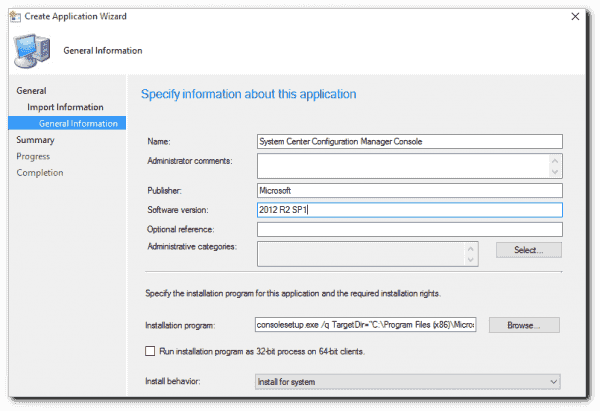
Configuring the installation program for the SCCM Console
TargetDir controls the installation directory. EnableSQM controls the Customer Experience Comeback Program. A value of 1 volition join the CEIP. Exist sure to change the DefaultSiteServerName value to your site server. Finish the Create Application Wizard.
Configuring SCCM application requirements and dependencies ^
Correct now, you take an SCCM application that will install the Configuration Managing director Console. Y'all may desire to do two additional advanced steps to configure your environment.
First, y'all may wish to restrict the operating system or system architecture that the application can be installed on. In the installation properties above, I manually specified that the application should install in Programme Files (x86). Obviously, I do not want a 32-flake machine to install the Console.
Enforcing this is easy. Right-click your newly created application and select Backdrop. Choose the Deployment Types tab and edit the unmarried deployment listed.
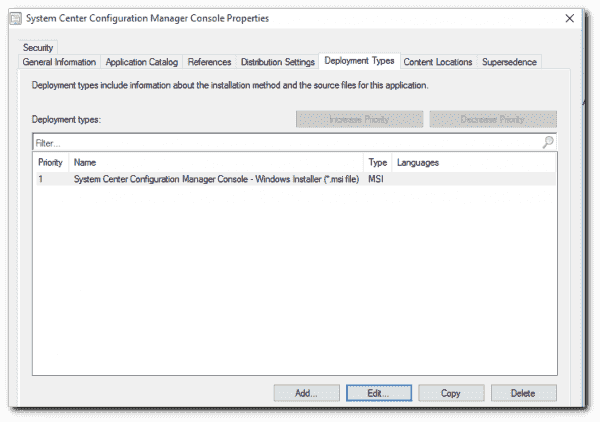
Multiple deployment types are used for compages-based installs or installers across device types.
In the new MSI file properties window, navigate to the Requirements tab and click Add. Under Status, choose Operating System and and then check the allowed operating organization values. Although this is outside the scope of this article, yous can too configure custom Global conditions. If yous begin to utilize atmospheric condition frequently, change their type to a Global Condition to centralize future changes. The end of this article details how to do this.
The Configuration Manager Console has a single prerequisite requirement. Machines must have the total version of .Cyberspace Framework four installed. If your machines do not already have this installed, you lot can download the standalone installer from hither. Import it every bit a new application past following the steps used during the Create Awarding Sorcerer section from above. For the command line, utilize:
dotNetFx40_Full_x86_x64.exe /q /norestart /ChainingPackage ADMINDEPLOYMENT
Once imported, navigate to the Dependencies tab on your SCCM Console MSI File Properties folio (screenshot beneath). Click Add. Select the .NET Framework 4 awarding that you lot imported and prepare the Install value to Aye.
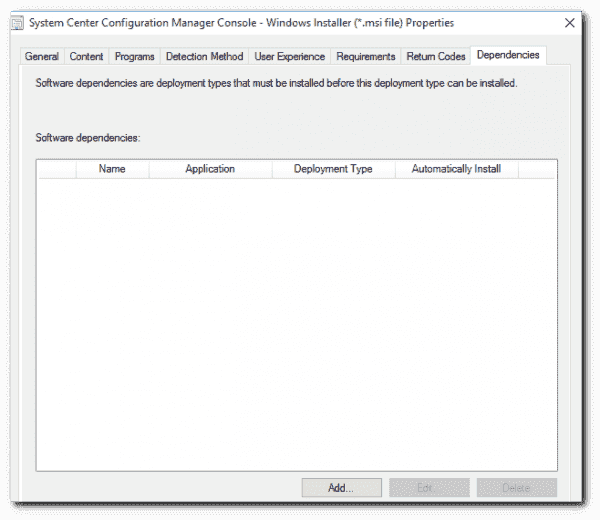
Calculation a dependency to an SCCM application
Creating an SCCM panel deployment collection ^
Whether y'all wrapped up your application before or added advanced features such as requirements or dependencies, yous still need to deploy information technology to a collection. For best results, I create two collections.
The first drove dynamically adds clients that already accept the Configuration Managing director Console installed. This ensures that all authoritative machines keep the same console version during futurity System Center updates.
Create a new device collection, name it, and specify a limiting collection (for example, All Desktop and Server Clients). On the Membership Rules folio, select Add – Query Dominion. Click the Show Query Language button and paste the following:
select SMS_R_SYSTEM.ResourceID,SMS_R_SYSTEM.ResourceType,SMS_R_SYSTEM.Name,SMS_R_SYSTEM.SMSUniqueIdentifier,SMS_R_SYSTEM.ResourceDomainORWorkgroup,SMS_R_SYSTEM.Client from SMS_R_System inner bring together SMS_G_System_ADD_REMOVE_PROGRAMS on SMS_G_System_ADD_REMOVE_PROGRAMS.ResourceId = SMS_R_System.ResourceId where SMS_G_System_ADD_REMOVE_PROGRAMS.DisplayName like "%Configuration Manager Panel%"
Create a second device collection. This time, choose a direct rule and filter to a grouping of computers that need the Panel installed on them. For the Configuration Managing director Console, I prefer direct deployments instead of deployments based on Advert grouping membership. After adding the computers, create a second collection rule and choose include collections. Add the first (query) collection that you created.
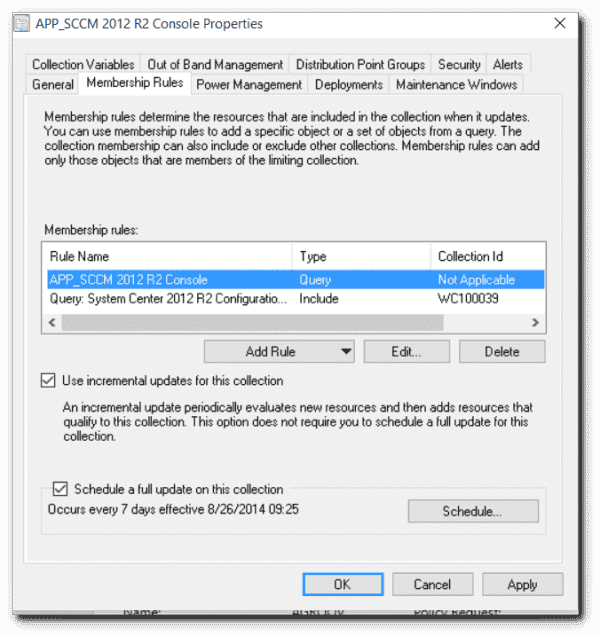
A device drove for the SCCM Console deployment
Your second drove should at present include computers manually slated to go the Configuration Manager Console every bit well equally any that afterward report information technology was installed. This is very handy for deploying Cumulative Update packages!
Right-click your second collection and choose Deploy – Awarding. Select your Configuration Manager Console application and continue through the wizard. In one case your content has been distributed and clients have seen the new policy, the Configuration Manager Console should kickoff installing!
Source: https://4sysops.com/archives/deploying-the-sccm-console-for-configuration-manager-2012/
Posted by: mcgriffholoo1954.blogspot.com


0 Response to "How To Install Configuration Manager Console 2012"
Post a Comment